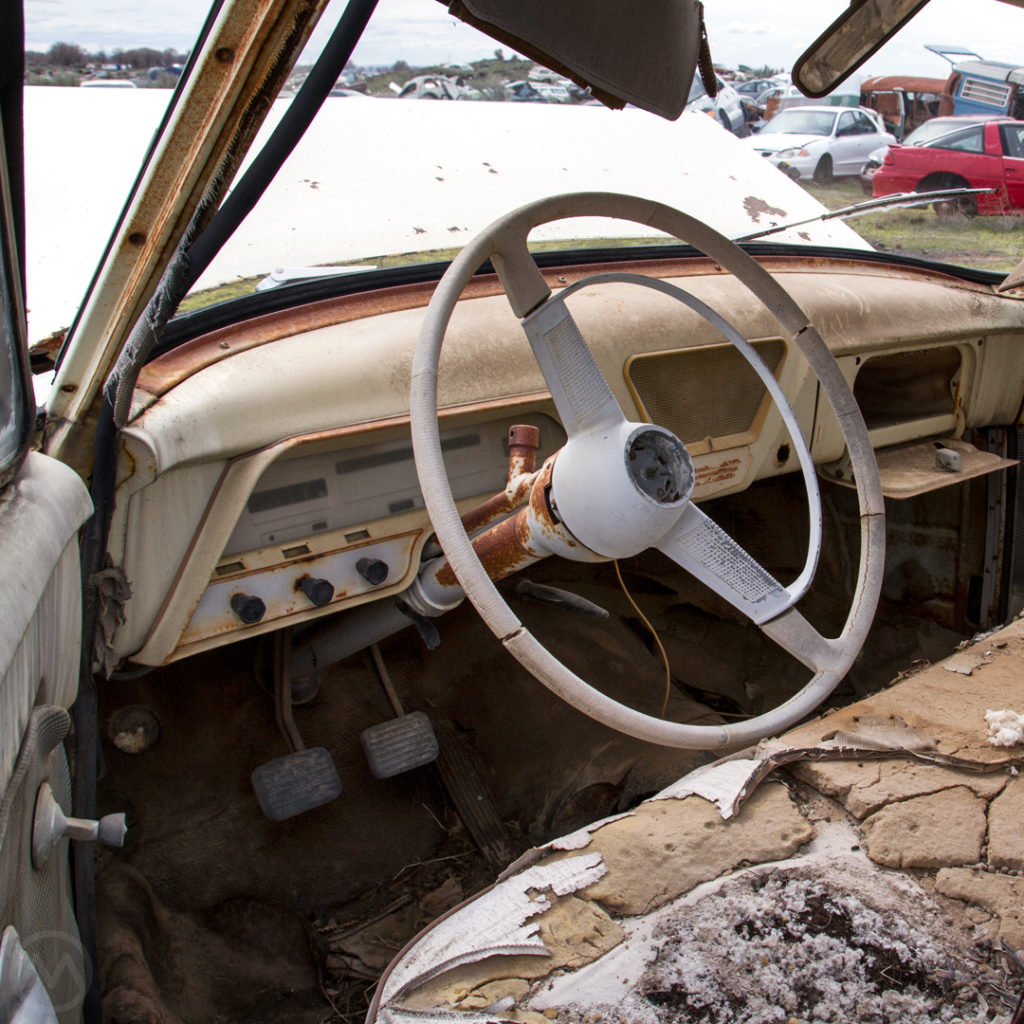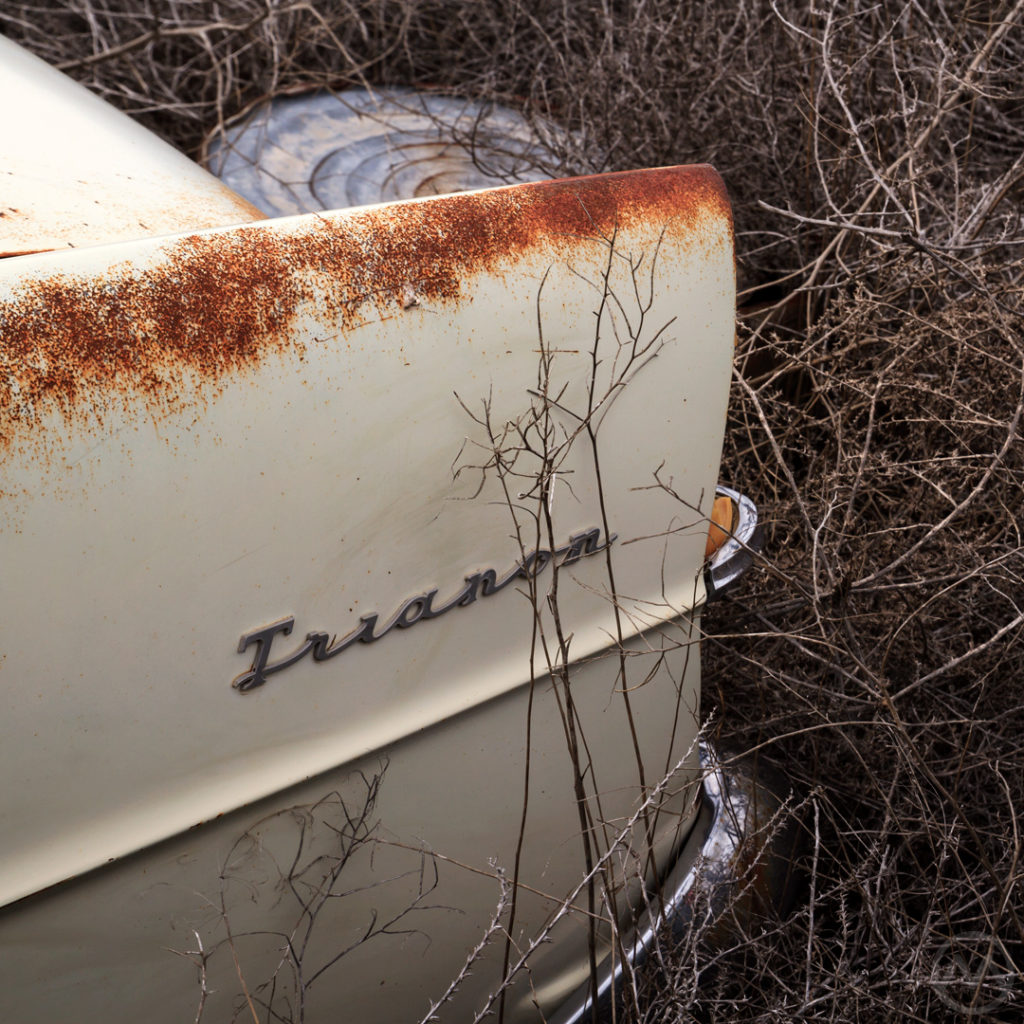The Simca Vedette began life as the Ford Vedette – and its history is as complex as a Château Latour red.
This Vedette Trianon, the base model at the time, dates from 1955, a period when Simca had just taken over Ford of France. This generation of Vedette – and there were several – was actually launched before the merger was finalized. The very first cars produced were still Fords, though everybody knew Simca was in charge.
In the USA, small importers (Max Hoffman, Witkin-Wolf) imported Simcas until Ford sold its remaining stake in the French company to Chrysler in 1958. After that, Chrysler dealers sold Vedettes – which were powered by … Ford Flathead V8s.
Ford of France
Ford of France dated to 1916 as a small-scale builder of Model Ts, but the Vedette’s ancestry dates to when Ford took a controlling interest in Emile Mathis’ eponymous company in 1934. The marriage between Ford and Mathis, better known as “Matford,” produced French Fords similar to American and British ones. It was, however, an unhappy union.
Emile Mathis and Ford ended up rarely seeing eye to eye and the tie-up was coming unglued by 1939. After WW2 the cars were Fords – the war and a corporate divorce having taken place.
In the meantime, Dearborn had designed a postwar “light car.” This smaller-than-normal car was designed by E.T. “Bob” Gregorie and was a scaled-down version of his 1949 Ford proposal.
In a move that presaged the “small cars, small profits” quote Henry Ford II uttered decades later, Ford decided against building the car because its production costs were just as high as a full-size car. That made it not worth bothering with in the eyes of Henry Ford II’s “Whiz kids;” more on them in a moment.
Ford shelved the “light car,” turned Gregorie’s original 1949 Ford proposal into the 1949 Mercury, and set about a crash program to design what became the actual ’49 Ford.
The “light car” wasn’t going to have a future in Detroit, so Ford SAF chief Maurice Dollfus successfully lobbied to have it come to France. The “light car” was a natural replacement for the small prewar-style French Ford V8s.
Plus, the new product could help Ford SAF utilize it’s mostly empty, new-in-1940 Poissy factory, a plant built to distance Ford from Mathis in Strasbourg during the Matford period.
The car bowed at the 1948 Mondial de l’Automobile in Paris, and it was easily the most stylistically up-to-date car in France at the time, though it lacked the mechanical sophistication of the Citroën Traction.

Small Flatheads to match French tax classes powered the new Vedette, though the car was only modestly successful. The Vedette was small by Detroit standards but still pretty big for France, and expensive to run. Initial quality issues also plagued the early cars, leading to a sour reputation, at least early on.
Then there was the management. When the competent and well-liked Dollfus retired in 1950, he was replaced by François Lehideux; who proved to be a disaster in Dearborn’s view.
Lehideux didn’t particularly want to take orders from Michigan, and often did things without permission. The Vedette-based Ford Comète may have been an achingly pretty car with its Facel body, but it was created with no approval from Detroit. Lehideux’s penchant for going off the reservation reportedly greatly angered Henry Ford II.
Lehideux was also cooking the books to hide rising financial losses. In 1952 Francis “Jack” Reith was sent to France to deal with Lehideux and either fix or close Ford SAF.
Reith was one of the original ten “Whiz kids” hired from the Army Air Forces’ Office of Statistical Controls after WW2. Their techniques and business acumen had greatly helped Henry Ford II after he found himself in control of the company, and so it was natural to believe that Reith might be able to turn around Ford SAF.
From Ford to Simca
Ultimately Reith found a buyer – Simca, newly flush thanks to the Aronde and breaking out from Fiat’s shadow.
Prior to the Aronde, all Simcas had been licensed Fiats, like Seat in Spain or Zastava in Yugoslavia. Simca chief Henri Pigozzi wanted Poissy to expand production and the Vedette to expand his range, and Ford had even freshly updated the Vedette’s styling and trim levels for a 1954 re-launch. Supposedly, Reith and Pigozzi were introduced at a U.S. State Department-hosted function in Paris.
Simca bought Ford SAF that summer, though the deal wasn’t really complete until the end of the year, and Reith returned home to a hero’s welcome. Overnight, the Ford Vedette became the Simca Vedette, though the earliest ones were still Fords.
At the new Vedette’s heart was a 2.4L “Aquillon” flathead with about 85hp, good for the car’s 2,500 lbs. This engine was a direct descendant of the circa-1936 60hp American flathead, which had also been used in European models where larger flatheads were prohibitively costly. The Vedette’s version was slightly bored out from the earlier iterations.
In any case, the late ‘54 Vedette looked flashy and new – and rather like a European Ford until a restyle in 1957 gave it “Forward look” style fins. In this first stage of the Simca Vedette’s life, the Trianon was the bottom of the range, with Versailles in the middle and Régence at the top. A station wagon, the Marly, was added in 1956.
Stateside Vedettes
All Vedettes are super rare in the United States, but particularly the early ones which were imported only in small batches – hardly anybody bothering to buy one of these would have bought the base model Trianon, though it was the lightest and therefore probably the fastest, though it was no hot rod out of the box.
It’s also likely that plenty of flathead performance parts could have been fitted, though buyers were probably not well aware of the connection.
In 1958, Chrysler took a stake in Simca and took over importation and distribution of all Simcas, Vedettes included. The cars were heavily promoted by Chrysler in 1958-59, when they were facelifted to look a little like Chrysler’s larger domestic cars; but the Vedette was never a common car stateside.

It was built in France into 1961, but production continued into 1969 in Brazil (as the Simca Esplanada). There it was treated to a big mechanical update in the early 1960s and then a restyle in 1966; though by then its 1950s proportions were quite evident. By then, the old flathead had been re-engineered locally in Brazil into an OHV engine.
This photo was taken quite a long time ago at the excellent L and L Classic Auto (we’re overdue for another visit), but this car was recently profiled by Steve Magnante on Junkyard Gold.
Not too long after this shot was taken, the car was severely damaged by a wildfire (which happens a lot in the American west – fortunately not too much was lost), but as you can see, it’d been sitting for decades before that happened.
Vedettes were a little easier to work on relative to other foreign cars thanks to the old powerplant though the “Aquillon” was not an exact match for the prewar Flatheads owing to its evolution in France. Parts in general, however, were often hard to get for Simcas – particularly of the pre-Chrysler variety. Even many of the Chrysler-stocked parts for later Vedettes dried up by the 1970s, leaving the remaining cars only to the most hard-core enthusiasts.

